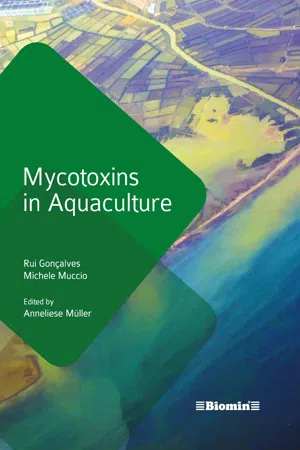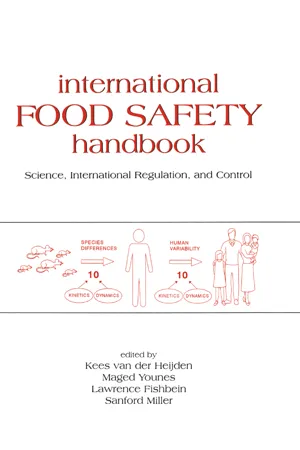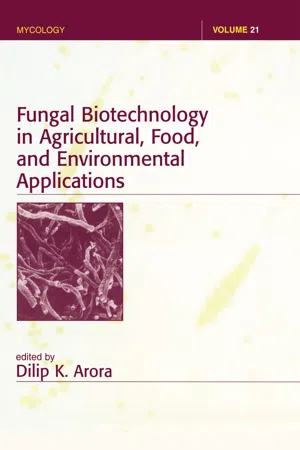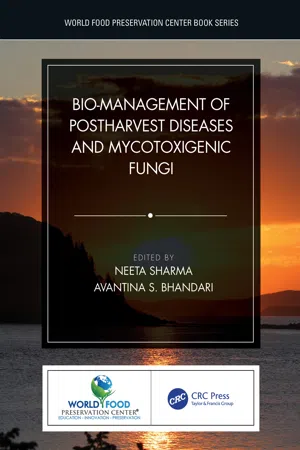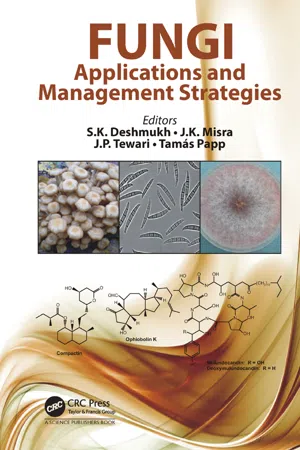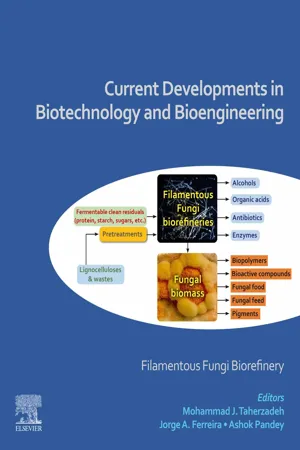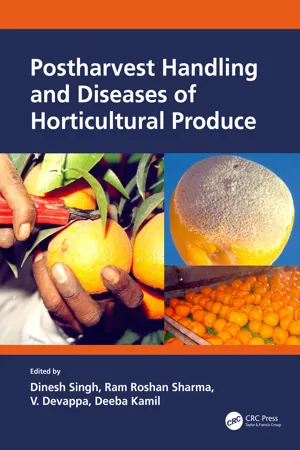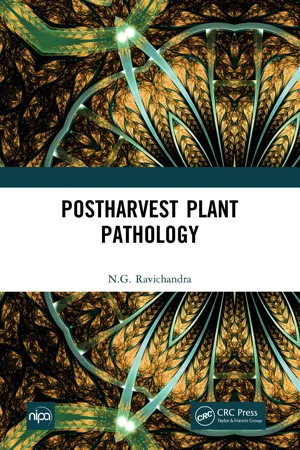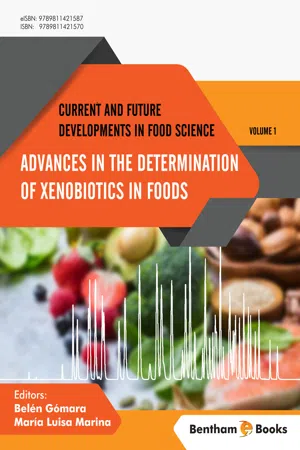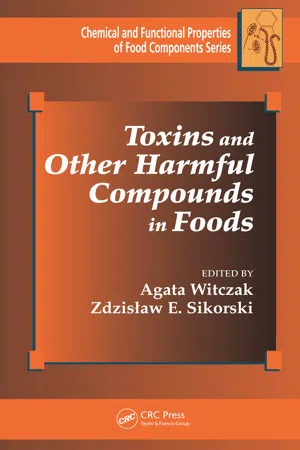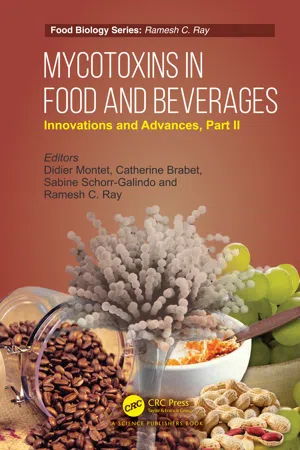Biological Sciences
Mycotoxins
Mycotoxins are toxic compounds produced by certain fungi that can contaminate food crops, posing a health risk to humans and animals. They are commonly found in grains, nuts, and spices, and can cause a range of adverse health effects, including liver damage, cancer, and neurological disorders. Mycotoxin contamination is a significant concern in food safety and agriculture.
Written by Perlego with AI-assistance
Related key terms
12 Key excerpts on "Mycotoxins"
- eBook - ePub
- Rui Gonçalves, Michele Muccio, Anneliese Müller(Authors)
- 2019(Publication Date)
- 5m Books(Publisher)
01 Mycotoxins – general conceptsKarin NAEHREREdited by Anneliese Mueller© Shutterstock, Kaulitzki1.1 What are Mycotoxins?Mycotoxins are naturally occurring secondary metabolites produced by certain molds/fungi. Whereas primary metabolites (e.g. amino acids, sugars, etc.) are essential for the survival of organisms, the benefit of many secondary metabolites, such as Mycotoxins, is not fully understood. Mycotoxins are chemical compounds of low molecular weight and low immunogenic capacity (Mallmann and Dilkin, 2007). There are some secondary metabolites of fungal origin with medicinal or industrial applications, for example, penicillin, but many exert detrimental effects on human and animal health, and animal productivity. Unfortunately, Mycotoxins are known to contaminate crops and consequently animal feeds and animal products. In addition to the negative impacts on health, their presence can lead to significant economic losses. Crops with large amounts of Mycotoxins often have to be destroyed (Vila-Donat et al. , 2018). The Mycotoxins that cause the biggest economic impacts on animal production are aflatoxins (Afla), trichothecenes (namely deoxynivalenol [DON] and T-2 toxin [T-2]), zearalenone (ZEN), ochratoxin A (OTA), fumonisins (FUM) and ergot alkaloids (Ergots). The focus of this book will be on these Mycotoxins.1.2 Mycotoxin-producing fungi
In general, the process of mycotoxin production by fungi is not well understood. Fungi, just like any living organism need nutrients to survive and they might have to compete for plant nutrients with the plant itself as well as with other microorganisms. Thus, Mycotoxins may allow the fungus to prevail in adverse conditions by conferring a competitive advantage over other organisms (Rankin and Grau, 2002). Some insights on the effect of Mycotoxins on the host plant have been gained for the mycotoxin DON: Its production has been found to prevent the formation of a thick cell wall, which could help the plant to avoid fungal infection. Furthermore, its production has been reported to be induced as a response to host defenses. Deoxynivalenol has also been observed to help the fungi to infect further until now healthy plant parts (Khaneghah et al. - eBook - ePub
International Food Safety Handbook
Science, International Regulation, and Control
- Vanderheijden(Author)
- 2019(Publication Date)
- CRC Press(Publisher)
On the basis of their origin, the natural toxins in food can be divided into five main categories: Mycotoxins, bacterial toxins, phycotoxins, plant toxins, and zootoxins. The first three categories involve biocontaminants. Biocontaminants are poisonous substances produced by living microorganisms. They are either formed directly in the food or food raw materials or they occur as a result of transfer through the food chain. The latter two categories involve inherent components that are harmful to humans and animals.In this chapter compounds formed through chemical, physical, or biotechnological processes of industrial or domestic origin will not be discussed, nor will the influence of the matrix, which may contain different modulating factors, on the effect of toxins be discussed [2 ].Mycotoxins are secondary metabolites of fungi which are capable of producing acute toxic, carcinogenic, mutagenic, teratogenic, and estrogenic effects on animals at normal levels of exposure. Biological conversion products of Mycotoxins are also referred to as Mycotoxins. The term mycotoxin is derived from the Greek words “ΜΥΚΗΣ” (fungus) and “ΤΟΞΙΚΟΝ” (arrow-poison). Toxic syndromes resulting from the intake of Mycotoxins by humans and animals are known as mycotoxicoses.Mycotoxicoses have been known for a long time. The first recognized mycotoxicosis was probably ergotism [3 ], a disease characterized by necrosis and gangrene of the limbs and better known in the Middle Ages in Europe as “holy fire”. This disease was caused by the ingestion of grain contaminated with sclerotia of Claviceps purpurea, which contained toxic metabolites. Another mycotoxicosis recognized to have seriously injured human populations is alimentary toxic aleukia (ATA) [4 ]. The symptoms of ATA in humans take many forms, including leukopenia, necrotic lesions of the oral cavity, the esophagus, and stomach, sepsis, hemorrhagic diathesis, and depletion of the bone marrow. The disease was induced by ingesting overwintered moldy grain and occurred in many areas in the Soviet Union, especially during World War II. It has been reported [5 ] that in 1944 more than 10% of the population in certain districts of the Soviet Union was affected and many fatalities occurred. The fungi responsible for these accidents belong to the genera Fusarium and Cladosporium. In Japan, toxicity associated with yellow-colored moldy rice was a problem, especially after World War II, when rice had to be imported from various countries [6 ]. The ingestion of “yellow rice” by humans caused vomiting, convulsions, and ascending paralysis. Death could also occur within 1–3 days after the appearance of the first signs of disease. The toxin-producing fungi in yellow rice belong to the genus Penicillium. In the early 1950s the so-called Balkan endemic nephropathy (BEN) was described for the first time. BEN is a human kidney disorder, which was later associated with the occurrence of ochratoxin A in food. Ochratoxin A is a mycotoxin formed by Aspergillus and Penicillium species [7 - Dilip K. Arora(Author)
- 2003(Publication Date)
- CRC Press(Publisher)
29 Mycotoxins
Fun S.Chu University of Wisconsin, Madison, Wisconsin, USADeepak Bhatnagar U.S. Department of Agriculture-Agricultural Research Service, New Orleans, Louisiana, USA1 INTRODUCTION
1.1 Mycotoxins, Mycotoxicosis, and Mycotoxicology
Mycotoxin is a convenient generic term describing the toxic secondary metabolites produced by fungi. “Myco” means fungal (mold) and “toxin” represents poison. They encompass a considerable variety of low molecular weight compounds with diverse chemical structures and biological activities. Some Mycotoxins could also be toxic to plants or other microorganisms; but these compounds are not classified as antibiotics of fungal origin. Like most microbial secondary metabolites, the benefit of Mycotoxins for the fungi themselves is still not clearly defined. In considering the effects of Mycotoxins on animals, it is important to distinguish between “mycotoxicosis” and “mycosis.” Mycotoxicosis is used to describe the action of mycotoxin(s) and is frequently mediated through a number of organs, notably the liver, kidney, lungs, and the nervous, endocrine, and immune systems. On the other hand, “mycosis” refers to a generalized invasion of living tissue(s) by growing fungi (CAST 2003; Chu 1998). Due to their diverse chemical structures, Mycotoxins may exhibit a number of biological effects, including both acute and chronic toxic effects as well as carcinogenic, mutagenic /genotoxic, teratogenic, and immunotoxic effects (Bhatnagar et al. 2002; Chu 1998; 2002; Wogan 1992). Modulation of the animal immunosystem, either immunosuppressive (most often) or immunostimulatory, also plays an important role for the overall toxic effects (Bondy and Pestka 2000). The interaction of Mycotoxins with cellular macromolecules plays a dominant role in their toxic actions (Chu 2002; Hussein and Brasel 2001). Recent studies on the effect of Mycotoxins on apoptosis have further revealed their mode of action at the cellular level (Chu 2002). The complexity of the biological effects of Mycotoxins has led to a scientific discipline named “mycotoxicology” for the study of various issues that are encountered with this group of toxins.- eBook - ePub
Fungi Bio-prospects in Sustainable Agriculture, Environment and Nano-technology
Volume 1: Fungal Diversity of Sustainable Agriculture
- Vijay Kumar Sharma, Maulin P. Shah, Shobhika Parmar, Ajay Kumar, Vijay Kumar Sharma, Maulin P. Shah, Shobhika Parmar, Ajay Kumar(Authors)
- 2020(Publication Date)
- Academic Press(Publisher)
Mycotoxins are group of toxic secondary metabolites and found in food and agricultural commodities which leads to illness in human and animals and economic loss to the country. During harvesting, processing, transportation, storage and handling, the substrates are very prone to fungal growth and leads to the subsequent production of secondary harmful metabolites called Mycotoxins. As per Food and Agriculture Organization report, merely 25% of World’s agricultural products are contaminated with Mycotoxins and the contaminated products are unfit for human consumption and leads to various chronic illness and fatal diseases. Mycotoxins affected the diversified food substrates and processed products like cereals, grains, cured meat, dairy products, beverages, infant foods, nuts and ready-to eat foods. Aflatoxins, deoxynivalenol, fumonisins, ochrotoxins and zearalenone, toxins are frequently affected the agricultural and food products. There are various efforts rendered towards the prevention and control of the Mycotoxins in food and agricultural products. Efforts are continuing to control the Mycotoxins using the biocontrol approaches mediated through microorganisms, enzymes, nano based tools and the early detection of Mycotoxins using biosensors.Keywords
Mycotoxins; Agricultural crops; Human diseases; Food safety; Prevention; ControlIntroduction
In a recent years with high concern about food safety and quality towards the high concern about health aspects of consumer. Comparing to other microbes, fungi affect plant crops and leads to reduction of yield, diminishing the quality and ultimately leads to the loss of economy (Adejumo and Adejoro, 2014 ; Richard, 2007 ). The secondary metabolites produced by fungi, called as Mycotoxins present in almost all food substances especially the crops infected by fungi and during the storage of crop products. The mycotoxin which responsible for mycotoxicoses, a low molecular weight secondary metabolite substances, which may contaminate the raw material by the way contaminate the food, feed and cause severe health damages to humans including infants, domestic animals and live stocks (Ashiq, 2015 ; Jeswal and Kumar, 2015 ). Various International agencies like Food and Agriculture Organization (FAO), United Nations Environment Programme (UNEP), World Health Organization (WHO), European Spice Association (ESA), American Spice Trade Association (ASTA), International Organization for Standardization (ISO) (Esmaillzadeh et al., 2013 ) European commission Scientific Committee on Food (SCF, 1998 ), Joint FAO/WHO Expert Committee on Food Additives (JECFA, 2001 - Neeta Sharma, Avantina Bhandari, Neeta Sharma, Avantina S Bhandari(Authors)
- 2020(Publication Date)
- CRC Press(Publisher)
Apart from food products, in developing countries, spoilage and contamination of drugs by fungi is another major problem, which has garnered the attention of scientists due to the amplification of Mycotoxins leading to serious quality deterioration (Guan et al. 2008).9.2 Mycotoxins
The growth of fungi on various postharvest products and crude drugs not only deteriorates their quality but also adds toxins. The fungi that are known to produce toxic chemicals are found in almost all major taxonomic groups. Toxic chemicals produced by fungi are collectively referred to as Mycotoxins and the diseases associated with the ingestion of mycotoxin contaminated food/feed stuffs are referred to as mycotoxicosis (Bennett and Klich 2003). These are characterized as toxic metabolites produced by a varied assemblage of fungal strains that taint agricultural crops before harvest or during postharvest storage. The range of these harmful substances is reasonably extensive (Zychowski et al. 2013). Mycotoxins are not only detrimental to human and animal health; they also account for huge monetary losses. These losses hurt all the participants viz ., production animals/animal producers, grain handlers and distributors, processors of crops and consumers (Rodrigues et al. 2011). At present, about 400 Mycotoxins have been recognized and characterized, however, the major attention is with those Mycotoxins that are toxic and carcinogenic in nature (Iqbal et al. 2013). The exposure of humans to Mycotoxins may be as a result of eating either plant-based foodstuffs that are contaminated with toxins or possess potent Mycotoxins and their metabolites (CAST 2003) or direct exposure to air and dust containing Mycotoxins (Jarvis 2002).Mycotoxins represent a group of unrelated chemical compounds produced as secondary metabolites by certain toxigenic isolates of fungi (Ismaiel and Papenbrock 2015). Mold produces several hundred toxic metabolites. In recent years, much emphasis has been given on Mycotoxins in human food and animal feed. Feeding on contaminated food can be harmful and lethal to living organisms, causing abnormalities at the cellular and physiological level (Fliege and Metzler 1999).- eBook - ePub
Fungi
Applications and Management Strategies
- Sunil K. Deshmukh, J. K. Misra, Jalpa P. Tewari, Tamas Papp(Authors)
- 2018(Publication Date)
- CRC Press(Publisher)
CHAPTER 14 Mycotoxins: Fungal Secondary Metabolites with Toxic PropertiesP.M. Canoa , O. Puelb and I.P. Oswald*ABSTRACT
Fungi are frequent contaminant of foodstuffs worldwide. According to environmental conditions and their own physiological particularities, they can develop on living plants in the field or during pre-harvest period as well as during storage in case of drying failure or re-moistening. During their evolution, the filamentous fungi have become one of the most important sources of secondary metabolites. Many of these secondary metabolites display properties interesting for pharmaceutical or food industry. But other metabolites, named Mycotoxins, have several detriment effects on both human and animals. The variety of biological activities of fungal secondary metabolites is directly related to the large diversity of these metabolites in terms of chemical structures. This chemodiversity is largely due to the variety of not only “backbone” enzymes like polyketide synthases (PKS), isoprenyl disphosphate synthases, non ribosomal peptide synthetases (NRPS) and dimethylallyltryptophane synthases (DMATS) but also the tailoring enzymes involved in their biosynthesis. Mycotoxins can thus be classified into four main categories: polyketides, terpenes, non ribosomal peptides and hybrids.This chapter presents a detailed overview of some of the most representative Mycotoxins of each of these categories with a special attention to Mycotoxins that are regulated in a great number of countries: aflatoxins, fumonisins, ochratoxins, patulin, zearalenone and trichothecenes. For the non ribosomal peptides category, gliotoxin and ergot alkaloids have been chosen for their relevance in terms of occurrence and toxicity. This chapter includes information on the current understanding of the mechanisms of their toxinogenesis and summarizes their toxicological effects. - eBook - ePub
Current Developments in Biotechnology and Bioengineering
Filamentous Fungi Biorefinery
- Mohammad Taherzadeh, Jorge Ferreira, Ashok Pandey(Authors)
- 2022(Publication Date)
- Elsevier(Publisher)
Mycotoxin, detrimental to human and animal health at a certain level, is a secondary metabolite produced by filamentous fungi. Up to date, there are 500 types of Mycotoxins that had been identified. The contamination of Mycotoxins in food and feed has tremendous economic impacts. Mycotoxins possess severe health impacts even in low concentrations. Mycotoxins exposure in developing countries tends to be higher than in developed countries. Their contamination has been reported in various important commodities, including cereals, spices, and fruits. According to the Rapid Alert System for Food and Feed (RASFF), Mycotoxins became the most reported hazard in agricultural products among European countries. This chapter provides a comprehensive review of Mycotoxins’ type, health impacts, occurrence, factors affecting mycotoxin productions, and processing stability of Mycotoxins. The chapter also addressed some reduction tools, detection methods, and risk management strategies for Mycotoxins. The risk management strategies include management control, networking, and recommendations. Although Mycotoxins contamination is difficult to be removed completely, but implementation of risk management strategies together with comprehensive regulation could minimize the impact of Mycotoxins.Keywords
Mycotoxins; Toxigenic fungi; Detection; Regulation; Control1: Introduction
Mycotoxins, first coined in 1962 after an incident involving aflatoxin (AF) and costing the death of approximately 100,000 turkey poults in London, are defined as toxin synthesized by filamentous fungi species as secondary metabolites that might pose a health hazard to human or vertebrates of other animal groups in low concentration and usually consists of low molecular compounds (Ashiq, 2015 ; Bennett et al., 2003 ). However, it is important to note that not all fungal toxic secondary metabolite is defined as mycotoxin. For example, an antibiotic is a fungal product that is mainly poisonous to bacteria. The same goes for other fungal toxins harmful to plants, but they are not classified as Mycotoxins. The presence of filamentous fungi also does not always imply mycotoxin occurrence because the fungi might also grow without secreting toxins. Compared to other fungal by-products, Mycotoxins have a wide selection of hosts and targets that cross-plant species.Currently, about 500 Mycotoxins are recognized. Mycotoxins classification is usually based on the fungal producers, chemical configurations, and (or) action mechanism. However, one type of Mycotoxins can be produced by several different species. Similarly, a single species of fungi might generate one or several types of Mycotoxins. Furthermore, a systematic definition of modified Mycotoxins and “masked Mycotoxins” had been proposed into four hierarchical levels to distinguish the unbound and unmodified Mycotoxins from biologically or chemically modified Mycotoxins and matrix-bound Mycotoxins (Rychlik et al., 2014 - Dinesh Singh, Ram Roshan Sharma, V. Devappa, Deeba Kamil, Dinesh Singh, R.R. Sharma, V. Devappa, Deeba Kamil(Authors)
- 2021(Publication Date)
- CRC Press(Publisher)
Mycotoxins that make anoxious impact on human and animal health are known as mycotoxicosis, and the study of mycotoxicosis is called mycotoxicology (Bennett and Klich 2003). Some fungal species that produce Mycotoxins which inhibit the growth of bacteria (like penicillin) are called antibiotics. The term mycotoxin was coined in 1962 as the result of Turkey X disease in which approximately 100,000 turkey poults died in England due to Mycotoxins (Blount 1961 ; Forgacs 1962 ; Maggon et al. 1977). During the study of Turkey X disease, scientists observed that peanut seeds were also contaminated with a flatoxins secreted by fungus Aspergillus flavus, and researchers found that the secondary metabolites produced by many moulds might be poisonous (Richard 2007). Later, nearly 400 Mycotoxins was identified; among them a flatoxins, ochratoxins, zearalenone, fumonisins and trichothecenes have great significance with respect to human health (Ates et al. 2013). Mycotoxins produced by fungus are not all toxic; the toxicity primarily depends on the quantity and period of dosage, type of mycotoxin and the physiological and nutritional status. On the basis of food toxicity, Mycotoxins are grouped in five major groups: aflatoxin, ochratoxin, fumonisin, deoxynivalenol/nivalenol and zearalenone. Based on Mycotoxins found in food, the fungi have been divided in two groups: field fungi, which attack the crop and fungal Mycotoxins that attack before harvest and storage fungi, which occur only after harvest. Mycotoxins can be produced in favourable conditions such as high temperature, high moisture content and unhygienic conditions during transportation and storage. These lethal Mycotoxins generally occur in animal feeds, crops and animal products. The highest level of Mycotoxins can be found in concentrated animal feed materials. The fungi contaminate another host such as plants and animals after establishment of infection and Mycotoxins in their existing host- eBook - ePub
- N.G. Ravichandra(Author)
- 2021(Publication Date)
- CRC Press(Publisher)
T-2 Mycotoxins are nonvolatile compounds produced by filamentous fungi primarily of the genera Fusarium, Myrotecium, Trichoderma and Stachybotrys. The potential for biological weapons to be used in terrorism is a real possibility. Biological weapons include infectious agents and toxins (Anderson, 2012). Toxins are poisons produced by living organisms. Toxins relevant to bioterrorism include ricin, botulinum, Clostridium perfrigens epsilson toxin, conotoxins, shigatoxins, saxitoxins, tetrodotoxins, Mycotoxins, and nicotine. Toxins have properties of biological and chemical weapons. Unlike pathogens, toxins do not produce an infection. Ricin causes multi organ toxicity by blocking protein synthesis. Botulinum blocks acetylcholine in the peripheral nervous system leading to muscle paralysis. Epsilon toxin damages cell membranes. Conotoxins block potassium and sodium channels in neurons. Shigatoxins inhibit protein synthesis and induce apoptosis. Saxitoxin and tetrodotoxin inhibit sodium channels in neurons. Mycotoxins include aflatoxins and trichothecenes. Aflatoxins are carcinogens. Trichothecenes inhibit protein and nucleic acid synthesis. Nicotine produces numerous nicotinic effects in the nervous system. Mycotoxins can be used as chemical warfare agents (Chu, 1997). There is considerable evidence that Iraqi scientists developed aflatoxins as part of their bioweapons program during the 1980s. Toxigenic strains of Aspergillus flavus and Aspergillus parasiticus were cultured, and aflatoxins were extracted to produce over 2,300 liters of concentrated toxin. The majority of this aflatoxin was used to fill warheads; the remainder was stockpiled. Aflatoxins seem a curious choice for chemical warfare because the induction of liver cancer is “hardly a knockout punch on the battlefield” (Stone, 2001). Even so, the repugnance caused by the use of chemical and biological weapons is the kind of emotional response that terrorists seek to elicit - Belen Gomara, Maria Luisa Marina(Authors)
- 2019(Publication Date)
- Bentham Science Publishers(Publisher)
91 ].Therefore, in order to minimize the uncertainty associated with the assessment of exposure through food analysis, in recent years important efforts have been carried out to assess the exposure to Mycotoxins through the development biomarkers of exposure which is measured by biological fluids and tissues and can be correlated with exposure to a specific compound [92 - 95 ].METABOLISM AND BIOMARKERS
From a toxicological point of view, the use of biological markers or biomarkers, have as main objectives to measure the exposure to a xenobiotic agent causing disease and to predict toxic response that could occur [96 ]. It implies that the toxic compound must be bioaccessible and bioavailable. The bioaccessibility refers to the amount of toxin released from the food matrix in the gastrointestinal tract and therefore it can be absorbed. Bioavailability refers to the bioavailable fraction of toxic reaching the systemic circulation from the gastrointestinal tract and is available to exert adverse effects. Beyond these concepts, it has to be also considered the metabolism and biotransformation of the toxic compound. The characterization of metabolites is of important consideration in the safety and risk evaluation of food contaminants because they can influence the overall toxic profile.Both the sensitivity and specificity are essential parameters in the development of biomarkers [97 ]. Several biomarkers of exposure for some of the Mycotoxins of greatest toxicological concern have been proposed in literature. For example, for AFB1 is proposed the urinary evaluation of AFM1 and the adduct 8,9-dihydro-8-(N7 -guanyl)-9-hydroxy-AFB1, products of their metabolism mediated by cytochrome P450 (CYP) as well as the albumin-AFB1 adduct in plasma [98 , 99- eBook - ePub
- A. Witczak, Zdzislaw Sikorski(Authors)
- 2017(Publication Date)
- CRC Press(Publisher)
Undoubtedly, mycotoxin is a unique challenge to food safety worldwide. According to FAO, at least 25% of the world’s food crops are contaminated with Mycotoxins, at a time when the production of agricultural commodities is barely sustaining the increasing population (Boutrif and Canet 1998). The global volume of such agricultural products as maize, groundnuts, copra, palm nuts, and oilseed cake, which are high-risk commodities, is about 100–200 million tonnes of which come from the developing countries (FAO 1997). The disposal of contaminated products or their diversion to nonhuman uses is not always practical and could seriously compromise the world food supply. Efforts to reduce and eliminate Mycotoxins in human foods and animal feedstuffs are based on two major concerns: (1) the adverse effects of mycotoxin-contaminated crops or feeds on human or animal health and productivity and (2) potential residues of Mycotoxins or toxic metabolites in edible animal food products.Reducing mycotoxin levels in food is a high-priority research. Preharvest interventions include production of genetically enhanced resistant crops, development of appropriate agronomic practices, determination of optimal stage for harvesting crops, and investigation of novel biocontrol and chemical control methods. Postharvest contamination by mycotoxigenic fungi usually occurs during storage and transportation and is normally a consequence of improper drying or exposure of the product to condensation or rain. Potential postharvest control measures include optimizing storage and transportation conditions, sorting to remove contaminated product, and applying chemical methods to prevent fungal growth. The development of biological control methods based on ecological and environmental parameters will be reviewed in this chapter.6.2 AFLATOXIN: SOURCES, AFFECTED FOODS, AND BIOSYNTHESIS
Aflatoxins are a family of fungal secondary metabolites exclusively produced by species in the genus of Aspergillus . The commonly recognized species that produce aflatoxins are A. flavus , A. parasiticus , A. nomius , A. tamarii , A. pseudotamarii , A. bombycis , A. ochraceoroseus , A. parvisclerotigenus, A. minisclerotigenes , and A. arachidicola - eBook - ePub
Mycotoxins in Food and Beverages
Innovations and Advances, Part II
- Didier Montet, Catherine Brabet, Sabine Schorr-Galindo, Ramesh C. Ray(Authors)
- 2021(Publication Date)
- CRC Press(Publisher)
Fumonisin B (FB) Induction of apoptosis in liver Tumorigenic in rodents Possibly carcinogenic to humans Group TDIb (for FB and modified form) 1 μg/kg bwc /day Kutsen et al. 2018 AflatoxinBl (AFB1) Genotoxic carcinogen Carcinogenic to humans Because of carcinogenicity, exposure should be kept as low as reasonably achievable. No health-based guidance value are set up by EFSA Schrenk et al. 2020aa ARfD: Acute Reference Dose; b TDI: Tolerable Daily Intake; c bw: Body weight3. Emerging Mycotoxins
Moreover, several fungal species can produce other Mycotoxins with toxicological properties such as beauvericin (BEA), enniatins (ENNs), and monoliformin (MON), a group of lesser-studied toxins called emerging Mycotoxins (Jestoi 2008) (a non-exhaustive list of mycotoxin producing Aspergillus, Penicillium and Fusarium species, split into eight groups, is provided in Table 2 ). Their frequent detection is partly a result of the continuous development of sensitive analytical methods with low detection limits (LODs) (Fredlund et al. 2013, Lindblad et al. 2013, Stanciu et al. 2017). Even if these mycotoxin-producing fungi differ according to ecological conditions, it is important to emphasize that Mycotoxins are found all over the world in foodstuffs and feedstuffs due to trade in these commodities that contributes to their worldwide dispersal. Moreover, Table 4 shows that one mycotoxin can be produced by several fungi, and that a fungus can produce several Mycotoxins.3.1 Toxicology of Emerging Mycotoxin: In Vitro Data
To follow in vitro toxicity mechanisms, common cells parameters can be monitored. First, cell viability and IC50 (inhibiting concentration 50%) values can be determined with MTT or neutral red assays. Measurement of the trans-epithelial electrical resistance (TEER) was performed to evaluate monolayer integrity and possible damage of the cellular monolayer during the experiments. The production of reactive oxygen species (ROS) – including superoxide radicals (O2 •− ), hydrogen peroxide (H2 O2
Index pages curate the most relevant extracts from our library of academic textbooks. They’ve been created using an in-house natural language model (NLM), each adding context and meaning to key research topics.
